Framing Statement:
What is site Specific performance?
Site specific performance is a form of post-dramatic performance “specifically generated from/for one selected site” (Wilkie, 2002, 150). Usually created in places of historical, political, or cultural significance, “it engages intensively with the history and politics of that place, and with the resonance of these in the present” (McAuley, 2007, 9). Considering this, I wanted to create a performance which explored the history of our site – the GCW Library – as a goods and grains warehouse, whilst still including its current significance as a place of study for the university’s students.
Our Performance
Our performance took place in the university library in the first floor refuge area, as well as us having a small station set up at the bottom of the main stairs, with the performance lasting 12 hours (9am-9pm). The performance involved us encouraging audience members to draw around their hands onto a piece of card and sign their name or initials, with the aid of written instructions and a demonstrative video. We then collected the hand outlines and took them to our work station in the first floor refuge area, where we filled in the outlines piece-by-piece with grain, displaying the final hands overnight on the wall along the staircase. Our audience was invited to follow the journey of their hand using a map which led them to our work station, allowing them to view the hands being filled and to take part if they so desired. Over the 12 hour period, just over 50 people took part by drawing around their hand, with 4 audience members actively participating in the making of the hands.
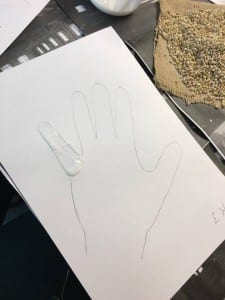
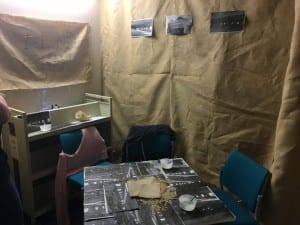
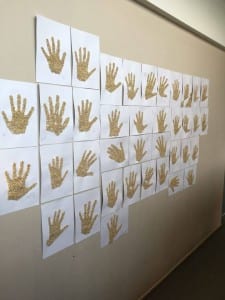
My initial research began by reading Mike Pearson’s Site Specific Performance, specifically focussing on the work of Fiona Wilkie. She mentions that site specific performance is “not just about a place, but the people who normally inhabit and use that space. For it wouldn’t exist without them” (Wilkie, 2002, 150). From this, I was influenced to heavily focus on the audience as part of performance, and the impact our final performance would have on the users of the library as both audience members and as inhabitants of the space. I also wanted to explore the buildings history as I felt the majority of its users (myself included) were unaware of the buildings past use. Since “Site-specific performance can be especially powerful as a vehicle for remembering… helping to evoke specific past times related to the place” (Harvie, 2005, 44), I thought this would be a good basis on which to form our performance.
Our final performance was practically influenced by Dreamthinkspeak’s One Day, Maybe, Lone Twin’s Totem, Marina Abramovic’s Counting The Rice, and Forced Entertainment’s Nights in this city.
Analysis of Process:
Scavenger Hunt
At the start of the creative process, I was interested in the library and the students who occupy it and wanted to explore the relationship between the users of the library (not only students, but the staff and visitors too) and how they interact with the space. After our initial exploration of the building as a group, we noticed details relating to the buildings history and past use, such as the buildings architecture which dates back to the late 1800’s. Certain features of the original building are still visible and have been made use of within the library today, such as the steel beams and the writing on the exterior walls. We felt that the building as it is now represented the viewpoint that “architecture is situated somewhere between the symbolic and the real” (Rufford, 2015, 16) with the recycled elements of the original build symbolising its past. With the library usually being thought of as a place of study and learning, we wanted to create a performance which would enable our audience to view the building from a different perspective, highlighting these key structural features.
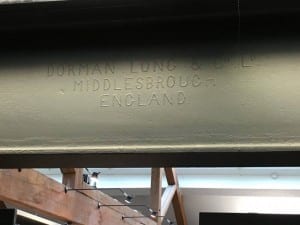
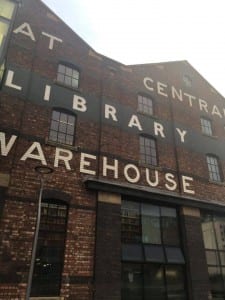
From this we decided the best way to utilise the whole space was to create a scavenger hunt. This would involve audience members following a map and clues through the library, with them being led to multiple points of the library we feel link to its history and often go unnoticed. However we felt this idea wasn’t truly suited to this one site, making it more site responsive (bordering on site generic) than specific.
Sensory Room
After deciding to scrap our scavenger hunt idea, we further investigated different parts of the space, paying close attention to the sounds and other sensor elements to the library. Within this exploration, we noticed that although the library’s third floor is a silent floor, the sound of quiet whispering, printers and typing can be almost deafening when payed close attention to. From this, we came up with the idea to create a sensory performance, focussing on interactive elements that link with sounds and smells that happen in the background of the libraries bustling workspace.
We also played Grandmothers Footsteps in class. This game involved moving from one side of the room to the other, with one person turning to catch you if you moved. During this experiment, I noticed that even when all the participants were standing still, there was a high level of energy in the room, with heightened senses. This was something we wished to incorporate into performance, as we felt a heightened level of awareness from our audience would make our performance more exciting for the audience, as well as creating an environment in which they were able to have immediate focus on the sounds and smells around them.
Our sensory room idea would involve us blindfolding our audience and leading them to a room on the third floor, in which we would have soundscapes and items to feel and smell, linked with the library (such as grain and old books). The audience member would then have to exit the library with a member of the group following them as though in the Grandmothers Footsteps, heightening their awareness of the space around them.
After discussion with Dr Karen Savage, we realised this idea wouldn’t work as a piece of site specific theatre. Not only did this idea have the potential to scare and overwhelm our audience, but we also realised that, again, the concept was transferable to different sites. We had built a performance around the library as a generic library space, rather than informing our performance using the buildings former state and history. In order to make our piece fully site specific, it must be “wholly in that site in both its context and form, otherwise, if moveable, it becomes more about site as a vehicle/vessel” (Wilkie, 2002). Rather than concern ourselves with the space as it is now, we chose to further focus more on its history as we originally intended.
Exploration of grain
After attempting to create overcomplicated performances using the whole library space, we narrowed our idea and chose to use one space within the library to enable us to focus more on our performance. After witnessing a site specific performance in the Lincoln Performing Arts Centre’s back staircase, we wanted to create a piece which still heavily focussed on our audience, but more so on the site itself. One member of the group suggested we host a tea party within the lift and refuge area, as these spaces would allow an intimate performance. We then developed this by thinking about the library’s history. We adapted the tea party to include repetitive mechanical movement, as well as grain, linking it to the past when it was a grains and goods warehouse.
When pitching this idea, it was suggested to us to continue developing a performance using grain, since that was the main part of the library’s history. This led us to creating a list of 101 things to do with grain, resulting in the creation of our final piece.
Final Performance – Lend a Hand
When creating our list of 101 things to do with grain, we chose to research post-dramatic performance artists and theatre companies who had created performances using a similar material. We came across Marina Abramovic’s performance Counting The Rice, which involved audience members sitting at a desk counting grains of rice for 3 hours. The piece was created to “develop endurance, concentration, perception, self-control, and willpower” (Marina Abramovic Institute, 2016). We were able to draw parallels between this and the library as a goods and grains warehouse, as the workers of the warehouse would have been transporting sacks of grain and doing other tedious tasks throughout their working day. We decided we wanted to do a repetitive task which would force us to push our boundaries and “stretch [our] physical and mental limits” (Marina Abramovic Institute, 2016) in order to represent the workers of the library as it was.
Through making our list of things to do with grain, we started by moving grain from one place to another, then by filling objects with grain. This resulted in the idea of filling in outlines of people’s hands with grain. By encouraging people to draw around their hands for us to fill with grain, we would be melding the current inhabitants of the library with the old inhabitants, “[exploring] spatial and material histories and [mediating] the complex identities these histories remember and produce” (Harvie, 2005, 44).
We were also inspired by Dreamthinkspeak’s One Day, Maybe. This piece was inspired by the Gwanju Uprising in South Korea, and involved the recreation of the atmosphere surrounding Gwanju’s marketplace (30 years after the uprising) being recreated in an abandoned building. Tristan Sharp mentions the performance aimed to answer the questions surrounding what the members of the uprising would think now, were they still alive. We wanted to do a similar thing in our piece by recreating the atmosphere of the library as a warehouse and encouraging the audience to question what conditions would have been like, and reflect on the changes to the library space today. We chose to do this by filling the hands in with grain, piece by piece, almost like a production line, recreating the atmosphere of the warehouse as a place of hard labour, long working hours and bad conditions. In order to create this, we covered the walls in Hessian (used to make grain sacks) and had a soundscape play in the background of our piece, made of machinery noises.
The way in which we involved the audience was partly inspired by Marina Abramovic (as mentioned), but also by Lone Twin’s Totem. This involved the pair of performers carrying a fallen telegraph pole through Colchesters town centre, carving the initials of those who assisted them onto the pole. In our piece, we chose to have the audience initial their grain hands in order to allow a more personal connection between them and the piece, with them having a permanent place in the performance. The act of carrying a telegraph pole over a great distance also influenced the laborious element of our piece, as we wanted for the “whole being in the performer – physical, mental, emotional – [to be] called on a high level of commitment” (Schechner, 2013, 174) to represent the workers. We therefore chose to make our performance durational, over the course of 12 hours to represent a day’s work in the warehouse.
Lastly, in order to stay within the conventions of a post-dramatic performance, we followed Forced Entertainment’s Nights in This City, which was a guided tour of Sheffield. Within this, the performers made “little attempt to pretend to be anything other than [themselves]” (Lowdon, 2013). In our performance, we chose to respond to the site and the audience as ourselves, with no character or narrative to our piece, only engaging with the audience if they spoke to us first or when asking people to join in our performance.
Evaluation of Performance:
On the day, I feel our performance was relatively successful. Aside from a couple of derogatory (and very rude) notes left with the hand outlines, we had a lot of positive interest in our piece. During the 12 hours, we had over 50 people participate by drawing around their hands, as well as 4 people actively join us creating the grain hands, which was a larger number of participants than we originally hoped for. We also had secondary audience participation, as users of the library walking past (without physically taking part) commented on our performance and could be heard discussing how interesting it looked, with one person starting a discussion with us asking what we were doing.
Throughout the performance, we developed certain aspects of our piece to improve our audiences experience, such as physically asking people join us make the grain hands (when people showed interest), as this was not originally an intended aspect of our performance. We also adapted the ways in which we filled the hands with grain, as the longer we worked, the faster we were able to fill the hands.
https://www.youtube.com/watch?v=am9Z3b7m3iI
However there were several weaknesses we encountered during the day. Firstly, we weren’t able to deal with the conditions of the site on the day as well as we would have liked. Temperatures on the day were quite high, and our performance area had little ventilation, was opposite a window (which only amplified the heat), and was very compact, meaning we were constantly surrounded by glue fumes. In future we would take measures to either better ventilate the area or possible use a different adhesive with less fumes.
As the day progressed we also ran out of supplies with which to make the grain hands. Although we were able to obtain more supplies without completely disrupting the performance, we could have prepared ourselves better and had more grain and glue on hand to prevent this from happening. Similarly, several details were left until the day before the performance to finalise.
Another weakness was our lack of focus. At points throughout the performance, especially the further it progressed, the group lost focus on the task of placing the grain on the hands and there was a lack of teamwork, with some members of the group lacking enthusiasm. This made our performance less cohesive and disrupted the working shift idea. I feel this happened in part due to it being a place we visit regularly. It was hard to stay focussed on being in the site as a performance space, and separating that from the library as a place we visit as students.
If I were to perform this piece again, I would try to focus more on the details of the performance space, as there was a lack of cohesion between the historical elements and newer details (the maps). I would also focus more on the production line idea, developing more tools to use when placing the grain on the hands. However, I would keep the element of care and precision that was used with the placing of the grain, as well as the nature of audience participation, possibly with more of an interactive role for the audience.
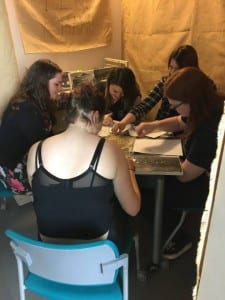

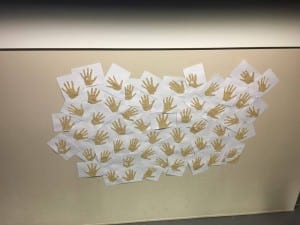
Having studied site specific performance, and finally having performed our piece, I feel as though I understand the subject more by having experienced it, although I was aware of site specific as a type of performance before. Throughout the module I struggled to apply the theory to my practical work, which meant developing a performance was more challenging than in other modules or within more typical performance styles. However, experiencing site specific performance has enabled me to view non-theatre spaces as potential performance areas, which I feel will benefit me when creating work in the future, and allow me to ‘think outside the box’ in regards to theatrical convention.
Word count: 2604
Works cited:
Abramovic, M. (2014) Counting the Rice. [Performance Art] Geneva, Switzerland.
Blench, A. (2016) Lincon. Print.
Blench, A. (2016) Silent Floor. Lincoln. Audio
Dreamthinkspeak (2013) One Day, Maybe by Dreamthinkspeak. [online video] Available from https://www.youtube.com/watch?v=yLUeQ90hu-Q [Accessed 11 March 2016]
Forced Entertainment (1995) Nights in this City. [Performance Art] Sheffield, UK.
Lone Twin (1998) Totem. [Performance Art] Colchester, UK.
Harvie, J. (2005) Staging the UK. Manchester: Manchester University Press.
Lowdon, R. (2013) Q&A with Forced Entertainment. [interview] Interviewed by Paul Clarke, 24 October.
Marina Abramovic Institute (2014) Counting The Rice. Marina Abramovic Institute. [online] Available from http://www.mai-hudson.org/calendar/2014/5/2/counting-the-rice?rq=counting%20the%20rice [accessed 23 March 2016].
Mcauley, G. (2007) Space in Performance. Michigan: University of Michigan Press.
OopsyAmy (2016) Lend a Hand. [online video] Available from https://www.youtube.com/watch?v=am9Z3b7m3iI [Accessed 13 May 2016]
Pearson, M (2010) Site Specific Performance. London: Palgrave Macmillan.
Rufford, J. (2015) Theatre and Architecture. London: Palgrave Macmillan.
Schechner, R. (2013) Performance Studies: An Introduction. 3rd edition. Oxon: Routledge.
Wilkie, F. (2002) Mapping the Terrain: A Survey of Site-Specific Performance in Britain. New Theatre Quarterly. 18 (2) 140 – 161.